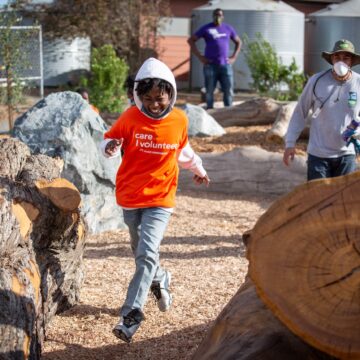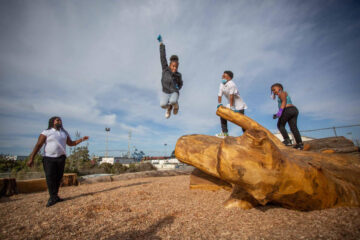Nature Exploration Areas (NEAs) are built play and learning environments made of local, natural materials designed for rich, sensory play experiences. Advantageous to kids, the environment, and the community, NEAs are becoming increasingly popular as a way to introduce outdoor play in areas without equitable access to nature.
The nature of childhood is changing. Despite the many benefits of time spent outdoors, childhood is moving indoors.
Kids today only spend an average of 7 minutes a day engaged in outdoor play. Approximately 75 percent of children under 12 don’t get enough unstructured play time. Nearly 30 million kids in the United States live farther than a 10-minute walk from the nearest park. These statistics are worse in communities of color, where historical inequities have prevented access to nature and play.
-
The percent of children under 12 who don’t get enough unstructured play time.
-
The average time kids spend outdoors daily
At KABOOM!, we unite with communities to build playspaces that spark joy and foster a sense of belonging for the kids who are often denied opportunities to thrive. When kids have access to playspaces, they are able to experience the full range of physical, mental, social-emotional, and developmental benefits of play. And when they are able to play outdoors and interact with nature, they become exposed to new play and learning opportunities. Achieving playspace equity through nature-rich playspaces provides these benefits to kids of all ages while supporting the creation of healthier communities and environments.
Developmental Benefits
Promotes Social and Emotional Development
Research has shown that nature-based play can help kids increase social connectivity, decrease peer conflict, and better identify others’ emotions.
Enhances Cognitive Development
NEAs invite open-ended, unstructured play. On traditional playgrounds, play equipment has specific purposes. For example, ladders are for climbing and slides are for sliding. With NEAs, there are no “rules” to follow, enabling kids to play or explore how they wish. Unstructured play can foster a sense of independence in kids, helping them form decision-making skills that will last a lifetime.
Improves Physical and Mental Health
Studies have found that adding natural elements to playgrounds helped enriches children’s microbiomes, which can protecting against allergies and autoimmune diseases.In a 2019 study, researchers found that kids who lived in neighborhoods with greater access to the outdoors had a reduced risk of depression, mood disorders, schizophrenia, eating disorders, and substance use disorder later on in life when compared to those who grew up in urban environments.
Environmental Advantages
Increases Appreciation for the Environment
People who play outside regularly as kids are more likely to be environmental stewards as adults. Creating early experiences with nature-based play provides important ecological learning opportunities.
Uses Sustainable Materials
Steel and plastic, two materials commonly used in traditional playgrounds, are highly polluting materials that are difficult to recycle. Materials used in NEAs break down naturally over time.
Provides Shading
Trees, vegetation, and other natural materials tend to cool environments by providing shade and moisture. Typical playground materials including plastic, metal, and pavement emit the sun’s heat, creating conditions that make their surroundings hotter. On an 85-degree day, a plastic slide can reach 150 degrees, potentially causing burns to visitors.
Community Impact
Provides Access to Nature Where None Existed
The unequal distribution of access to nature in the United States is well documented. Often described as the “Nature Gap,” racial and economic disparities have created barriers to nature in communities of color that NEAs can help mitigate.As kids lead increasingly structured lives, NEAs provide a way to experience the many health and developmental benefits of time spent in nature.
Customizable to Different Environments and Communities
Because of their versatility, NEAs can be customized to fit a community’s needs or preferences.
Examples of Nature-Rich Playspaces
Heron's Head Park
For 20 years, Heron’s Head Park in San Francisco has been considered an ecological haven for the city. However, residents in the Bayview Hunters Point neighborhood where the park is located have faced generations of racial discrimination, limiting their ability to access places to play. KABOOM! and partners worked to design and build a NEA that is responsive to the community’s culture, needs, and preferences. This playspace won the UNICEF Cities Inspire Award in the “Safe, Clean, Sustainable and Child-Friendly Environments” category.
The Autism Nature Trail
Through the Play Everywhere Design Challenge, the Autism Nature Trail (The ANT) at Letchworth State Park is a community-designed space that provides an inclusive place for kids to engage in nature-based, sensory exploration and play in a natural setting.
Through the 25 in 5 Initiative to End Playspace Inequity in San Francisco, KABOOM! and San Francisco Recreation and Parks are leading an ambitious plan to address gaps in access to quality, nature-rich children’s playspaces in communities that disproportionately lack resources. The first phase of the initiative involves building Nature Exploration Areas in four priority parks in the city. Other programs, such as the Play Everywhere Challenge, allow communities to design nature-based play programs that are accessible to kids and families in everyday, but unique, spaces.


